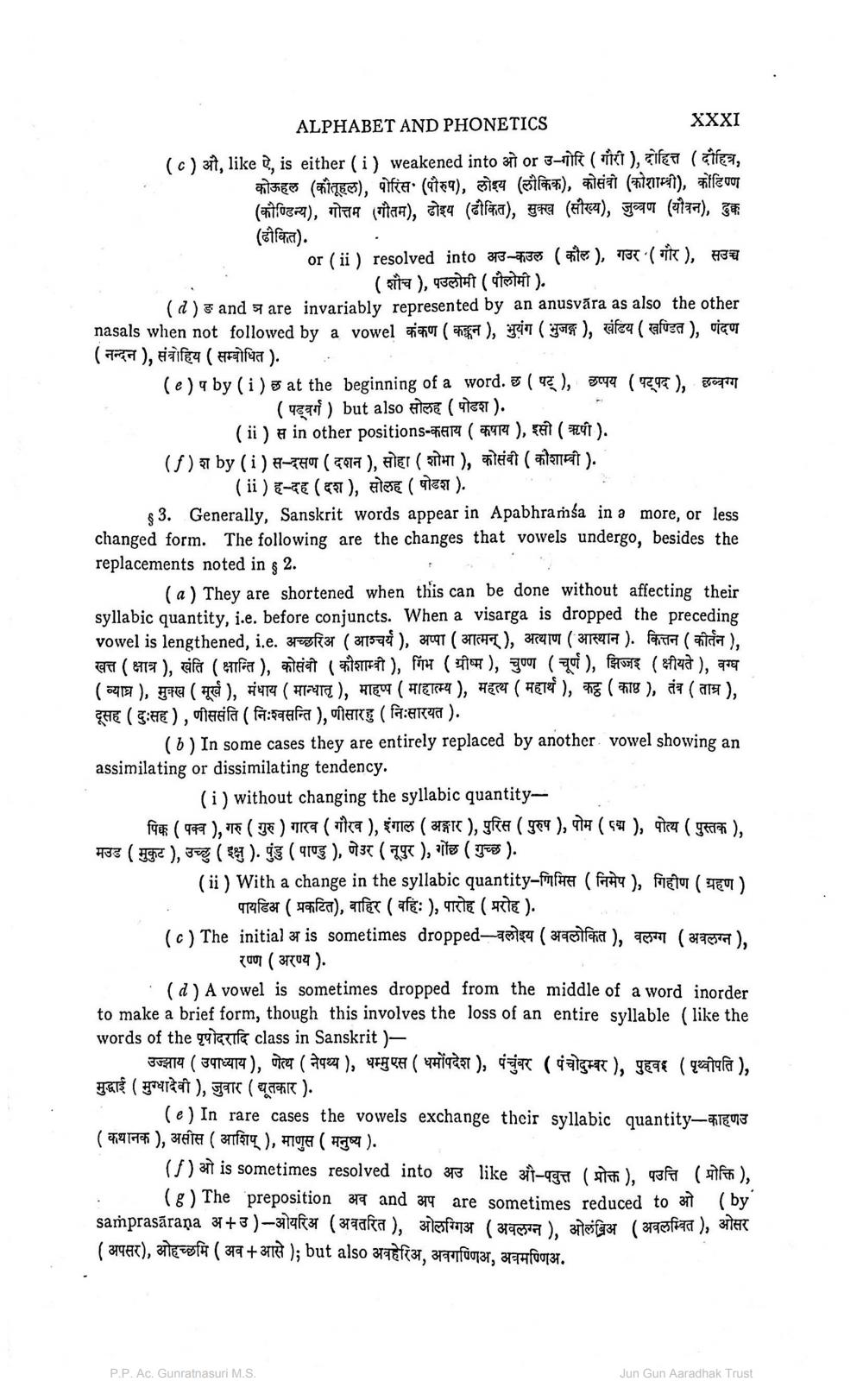________________ ALPHABET AND PHONETICS XXXI (0) औ, like ऐ, is either (i) weakened into ओ or उ-गोरि ( गौरी), दोहित्त (दौहित्र, कोऊहल (कौतूहल), पोरिस (पौरुष), लोइय (लौकिक), कोसंबो (कोशाम्बी), कोटिपण (कौण्डिन्य), गोत्तम (गौतम), ढोइय (ढीकित), सुक्ख (सौख्य), जुब्बण (यौवन), दुक्क (ढीकित). . ___or (ii) resolved into अउ-कउल (कौल), गउर ( गौर), सउच्च (शौच), पउलोमी (पौलोमी). (d) and 5 are invariably represented by an anusvara as also the other nasals when not followed by a vowel कंकण ( कङ्कन), भुयंग (भुजङ्ग), खंडिय ( खण्डित ), णंदण (नन्दन ), संबोहिय ( सम्बोधित ). (e) प by (i) छ at the beginning of a word. छ ( पट् ), छप्पय (पट्पद ), लब्बग्ग (पवर्ग) but also सोलह (पोडश). (ii) स in other positions-कसाय ( कपाय ), इसी ( ऋषी). (1) श by (i) स-दसण (दशन ), सोहा ( शोभा ), कोसंवी ( कौशाम्बी ). (ii) ह-दह (दश), सोलह ( षोडश). $3. Generally, Sanskrit words appear in Apabhramsa in a more, or less changed form. The following are the changes that vowels undergo, besides the replacements noted in $ 2. (a) They are shortened when this can be done without affecting their syllabic quantity, i.e. before conjuncts. When a visarga is dropped the preceding vowel is lengthened, i.e. अच्छरिअ (आश्चर्य), अप्पा (आत्मन् ), अत्थाण ( आस्थान ). कित्तन ( कीर्तन ). खत्त (क्षात्र ), खंति (क्षान्ति ), कोसंबी ( कौशाम्बी), गिंभ (ग्रीष्म ), चुण्ण (चूर्ण), झिज्जइ (क्षीयते ), वग्ध (व्याघ्र ), मुक्ख ( मूर्ख), मंधाय ( मान्धात), माहप्प ( माहात्म्य ), महत्थ ( महाथे ), कट्ठ ( काठ ), तंब ( ताम्र). दूसह ( दुःसह ), णीससंति (निःश्वसन्ति ), णीसारहु (निःसारयत ). (6) In some cases they are entirely replaced by another vowel showing an assimilating or dissimilating tendency. (i) without changing the syllabic quantityपिक ( पक्व ), गरु (गुरु ) गारव (गौरव ), इंगाल ( अङ्गार ), पुरिस (पुरुष), पोम (एम), पोत्य (पुस्तक) मउड ( मुकुट ), उच्छु ( इक्षु ). पुंडु ( पाण्डु ), णेउर (नूपुर ), गोछ ( गुच्छ ). (ii) With a change in the syllabic quantity-गिमिस (निमेप ), गिहीण ( ग्रहण ) पायडिअ ( प्रकटित), बाहिर ( बहिः ), पारोह (प्ररोह ). (0) The initial अ is sometimes dropped-वलोइय ( अवलोकित ), वलग्ग ( अवलग्न), रण ( अरण्य ). (d) A vowel is sometimes dropped from the middle of a word inorder to make a brief form, though this involves the loss of an entire syllable (like the words of the quazifa class in Sanskrit ) उज्झाय ( उपाध्याय ), णेत्थ ( नेपथ्य ), धम्मुएस ( धर्मोपदेश ), पंचुंबर (पंचोदुम्बर ), पुहवा ( पृथ्वीपति ), मुद्धाई ( मुग्धादेवी), जुवार (यूतकार ). (e) In rare cases the vowels exchange their syllabic quantity-काहणउ ( कथानक ), असीस (आशिप् ), माणुस ( मनुष्य ). (J) ओ is sometimes resolved into अउ like औ-पवुत्त ( प्रोक्त ), पउत्ति (प्रोक्ति ), (8)The preposition 37 and 374 are sometimes reduced to 377 (by samprasarana अ+उ)-ओयरिअ (अवतरित), ओलग्गिअ ( अवलग्न ) ओलंबिअ ( अवलम्बित ), आसर ( अपसर), ओहच्छमि ( अव+आसे); but also अवहेरिअ. अवगणिअ, अवमण्णिअ. PP.AC.Gunratnasuri M.S. Jun Gun Aaradhak Trust




